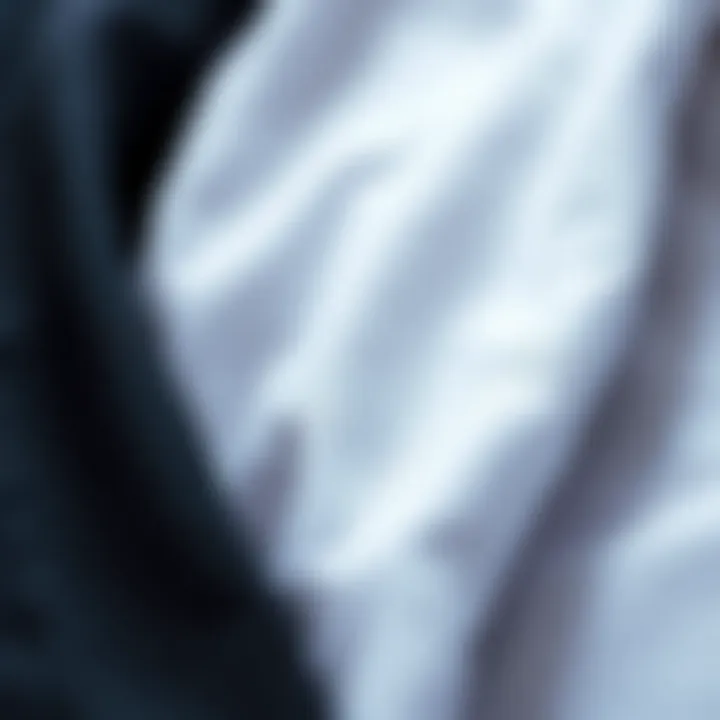Dress Clothes for Work: A Comprehensive Guide


Intro
In today's work environment, choosing the right attire isn't just about looking polished; it's a vital aspect of professional identity. The clothes we wear can convey a wealth of information before we even say a word, and understanding this can make all the difference in how we are perceived. With a myriad of options available, from polished blazers to smartly tailored trousers, the choices can be overwhelming. Yet, there exists an art to balancing corporate expectations with our personal style.
One's wardrobe can significantly impact confidence levels. Creating an ensemble that reflects both professionalism and individuality helps navigate the complexities of workplace cultures that can differ significantly from one organization to another. This article aims to provide insights into the distinctive styles, fabrics, and color palettes that not only enhance your professional image but also ensure you feel genuine and true to yourself.
As we explore these facets of work attire, keep in mind that your clothing choices can be a reflection of your ambition and approach to your career. With various tips and tricks, this guide will assist you in curating a wardrobe that speaks to your personal brand while adhering to the social norms of the working world.
Understanding Dress Codes
Understanding dress codes is crucial in the professional world, as it helps set the tone for how employees are perceived by colleagues, clients, and the broader public. Different work environments demand specific attire that often reflects the company's culture and ethos. Navigating these guidelines not only impacts individual confidence and comfort but also plays a significant role in establishing credibility and professionalism.
In essence, adhering to a dress code can serve as a form of respect toward one’s workplace and those with whom they collaborate. Knowing when to put on a sharp suit, a relaxed blazer, or even casual attire requires awareness and sensitivity to the unwritten rules that govern workplace dynamics.
Formal Attire
Formal attire remains the gold standard in many corporate environments, particularly in industries such as finance, law, and high-level consulting. This dress code typically demands tailored suits, polished dress shoes, and conservative accessories. For women, this could include tailored dresses, or skirts paired with blouses and blazers.
The importance of formal attire lies in its ability to display authority and professionalism. For instance, a crisp white blouse under a fitted jacket can evoke strength and reliability in settings like board meetings or client presentations. On the flip side, one should steer clear of overly flamboyant patterns or colors that could detract from the seriousness of a formal occasion.
Business Casual
Business casual has emerged as a popular bridge between the rigidity of formal attire and the comfort of casual wear. This dress code allows employees to exude professionalism while enjoying more freedom in personal expression. For instance, women might opt for tailored trousers paired with a smart blouse and loafers.
However, the interpretation of business casual varies widely between organizations. This makes it vital to observe others in the workplace initially.
- Avoid overly casual items such as flip-flops or ripped jeans.
- Consider structured fabrics to maintain a polished appearance.
- Choose colors that reflect confidence without screaming for attention.
Smart Casual
Smart casual often represents a mix of both traditional and more relaxed elements. This code, while still maintaining professionalism, allows for innovative combinations that can showcase individual style. Picture a well-fitted blazer over a simple yet elegant top or trousers paired with fashionable flats.
The trick here lies in balancing comfort with formality. For example, a soft sweater over tailored pants can create an approachable, yet conscientious, work persona. Attention to detail in this dress code is key—accessorizing smartly can elevate a smart casual look from simply acceptable to truly memorable.
Casual Fridays
Casual Fridays offer a welcomed respite from the week’s more formal attire. Typically, employees can wear more relaxed clothing, though it must still align with workplace standards.
While the specifics can vary between companies, casual doesn’t mean careless. A pair of well-fitting jeans paired with a stylish top can bridge the gap. However, one should be cautious with items such as
- T-shirts with offensive graphics
- Overly distressed jeans
- Casual sandals
Even amidst the relaxed vibe, straddling the line between casual and professional ensures that one’s appearance remains respectful and conscientious.
In summary, understanding the nuances of different dress codes allows for thoughtful choices that positively impact perceptions within the workplace. By adapting to various expectations—be it formal, business casual, smart casual, or casual Fridays—professionals can express both respect for their environment and their unique personal style.
Essential Elements of Work Attire
Understanding the essential elements of work attire is critical for crafting an effective professional image. The clothes worn to work can significantly influence perceptions, boost self-confidence, and even impact productivity. This section outlines the fundamental aspects that contribute to a well-rounded work wardrobe. Each element not only speaks to personal style but also to how one aligns with organizational culture and expectations.
Choosing the Right Fabrics
When it comes to work attire, the choice of fabric is paramount. Different fabrics offer various benefits and drawbacks, influencing both comfort and professionalism. For instance, fabrics like cotton allow breathability, making them ideal for long workdays, while wool is often associated with a polished look and warmth during colder months.
Consider the following:
- Breathability: Choose lighter fabrics such as linen during warmer seasons to stay cool.
- Durability: Blends, like polyester and cotton, can endure the wear and tear of a busy work life.
- Maintenance: Understand how easy it is to care for your clothing. Stain-resistant fabrics can be a lifesaver in a fast-paced environment.
It's wise to invest in quality materials that enhance both comfort and aesthetics. Remember, the feel of the fabric against your skin can affect your demeanor and focus throughout the day.
The Importance of Fit
Fit is possibly the most pivotal element in determining the effectiveness of your work attire. An ill-fitting outfit can undermine the sophistication you're aiming for, no matter how exquisite the fabric may be.


Here’s what to keep in mind:
- Tailoring: A tailored piece can transform simple clothing into something that exudes confidence. Adjustments might seem unnecessary, but the difference is eye-opening.
- Comfort: If you’re constantly tugging at an outfit, your attention is diverted. Very few people can give their best when they're distracted by discomfort.
- Body Shape: Understand your own body shape and select pieces that complement your figure. Some may find that higher-waisted trousers provide a more flattering fit, while others shine in tailored blouses that form to the silhouette.
Invest time in understanding your body and how different cuts can enhance or detract from your overall appearance. As the saying goes, "A good fit is worth its weight in gold."
Color Psychology in Work Clothes
The colors we choose to adorn our body carry psychological weight. In a work environment, specific colors can evoke emotions and convey messages without speaking a word.
Here’s a quick rundown of how color can influence perception:
- Blue: Often seen as trustworthy and dependable, a navy suit can set a serious tone.
- Black: Commanding and professional, black is timeless, yet it can appear overly formal, depending on context.
- Gray: A versatile color that exudes neutrality and balance, gray suits many settings and pairs well with various other shades.
- Pastels: Lighter hues may impart a sense of approachability and warmth, often used in creative fields.
By understanding color psychology, you can select your attire to not just fit in but to set the right tone for your presence—be it assertive in meetings or approachable when networking.
"Clothing isn’t just about covering the body; it’s about communicating who you are before you even say a word."
With these critical elements in place, you begin to build a wardrobe that doesn’t just fill a closet, but rather speaks volumes about your professionalism and attention to detail.
Staple Wardrobe Pieces
When it comes to dressing for work, having staple wardrobe pieces is essential. These core items serve as the foundation of any professional wardrobe. They can be mixed and matched, creating a variety of outfits without needing to break the bank. This section will discuss some of the key pieces that every professional woman should consider, emphasizing their significance and practicality in the workplace.
Blazers and Suit Jackets
Blazers and suit jackets are arguably the cornerstone of formal and business casual attire. They lend an air of authority and professionalism that few other pieces can match. A well-fitted blazer can elevate even the simplest of outfits. Think of it as the cherry on top of your ensemble.
Choosing a blazer comes down to a few considerations:
- Fit: A jacket that hugs the shoulders and cinches at the waist creates a sophisticated silhouette. Loose or oversized jackets may come off as unprofessional.
- Color: Classic shades such as black, navy, or gray will easily integrate into any wardrobe. Alternatively, a bold color might work well in creative environments.
- Material: Lightweight fabrics are perfect for warmer weather, while heavier materials like wool are ideal for winter months.
“A good blazer can make your outfit; a great blazer can make your day.”
Dress Shirts and Blouses
Dress shirts and blouses are vital staples that combine comfort with professionalism. They can be dressed up or down depending on the context. Think about how easily you can switch from a meeting to lunch with colleagues, just by unbuttoning a couple of top buttons or switching from a tailored shirt to a more relaxed blouse.
When selecting these shirts, consider:
- Fabric: Cotton blends offer breathability while stretch fabrics provide comfort and movement.
- Styles: Button-up shirts give a classic, tailored look, whereas blouses might add a flirty touch with ruffles or patterns.
- Versatility: Opt for neutral colors that can pair with various pants or skirts.
Tailored Pants
Investing in tailored pants goes a long way toward achieving a polished look. Unlike regular slacks, tailored pants are designed to offer a snug yet comfortable fit, enhancing your figure without compromising on ease.
Considerations to keep in mind include:
- Cut: Straight leg or slightly tapered styles tend to complement various body types and can be worn in many professional settings.
- Length: Ensure that the hemline sits just above the shoe or an inch or two off the ground to avoid dragging.
- Functionality: Look for pants with pockets that aren’t bulky, which adds practicality without disrupting style.
Knee-Length Skirts
Knee-length skirts provide a chic alternative to pants and are particularly useful during warmer months. They strike a balance between femininity and professionalism, making them suitable for various occasions. Options range from pencil skirts to A-line cuts, each serving a unique purpose in a professional wardrobe.
Factors to consider:
- Fit and Shape: Pencil skirts hug the curves while A-line skirts flare out; both styles can highlight different body shapes.
- Material Choices: Stiff fabrics can give structure, whereas softer materials may offer comfort. Choose what feels best for the day's needs.
- Layering Potential: These skirts easily layer with blazers or cardigans, giving you more outfit combinations.
Dresses for Client Meetings
Dresses for client meetings can be a game-changer. They effortlessly combine style with professionalism. A well-chosen dress not only showcases your fashion sense but also signifies respect for the role and the occasion.
When selecting a dress, keep in mind:
- Length and Cut: Aim for knee-length or slightly longer, and opt for cuts that compliment your figure without being overly revealing.
- Straps and Sleeves: Short sleeves or cap sleeves are often more appropriate than sleeveless for a business environment.
- Pattern and Color Choices: Subdued prints or solid colors tend to leave a lasting impression. Avoid loud colors that might distract from your message.


Accessorizing for Professional Impact
When it comes to making your mark in a professional setting, the right accessories can be the cherry on top of your overall attire. Accessories are not just about adding flair; they serve practical purposes and enhance your professional image. Consider them tools that, when chosen thoughtfully, eloquently communicate your style and competence. The goal is to choose elements that complement your outfit while remaining appropriate for the work environment.
Choosing the Right Footwear
Footwear is arguably the most critical accessory in a professional wardrobe. Think of it this way: you wouldn't want a beautiful dress to be overshadowed by a pair of clunky shoes. Instead, opt for options that merge both comfort and class. Points to ponder include:
- Heel Height: High heels can elongate your legs and boost your confidence, but they're not for everyone. Always consider your comfort, especially if you're on your feet all day. A classic pump or a wedge can provide stability without sacrificing style.
- Colors and Materials: Stick to neutral colors like black, navy, or beige for versatility. However, don’t be afraid to express yourself with softer hues or textured materials like suede or leather to add that understated pizzazz.
- Condition Matters: Ensure your shoes are in good shape. Scuffed or worn footwear can send the wrong message about your professionalism.
"The shoes you wear are the foundation on which your image stands. Choose wisely."
The Role of Jewelry
The influence that jewelry holds in professional attire is often underestimated. While you want to avoid overloading on accessories, a few well-placed pieces can make a positive impact. Here are some considerations:
- Simplicity is Key: Opt for minimalist pieces like stud earrings or a delicate watch. They can highlight your personal style without being distracting.
- Cultural Sensitivity: Be aware of cultural norms regarding jewelry in your work environment. Some workplaces may favor more conservative choices, while others allow for expression.
- Gold versus Silver: While personal preference plays a role, think about which metals complement your skin tone and the colors you wear. Gold may project warmth, while silver tends to offer a cooler, modern edge.
Bags and Briefcases
In the landscape of professional accessories, bags and briefcases play a utility role that can’t be overlooked. They should not only house your necessities but also complement your overall look.
- Size Matters: Choose a bag that’s practical for your daily needs. A medium-sized tote is great for carrying documents, while a structured briefcase can convey a polished image.
- Fabric Selection: Leather is considered a classic choice and can withstand daily wear and tear, while canvas may be more suited for a casual vibe. Look for items that meld functionality with style.
- Organizational Features: Having specific compartments for laptops, pens, and other essentials can vastly improve your efficiency. A disorganized bag can lead to a chaotic start to your day.
When you accessorize thoughtfully, you not only elevate your attire but also create a lasting impression. Each element, whether it’s footwear, jewelry, or a bag, works in concert to communicate your professionalism and attention to detail. Taking the time to select accessories that align with your personal brand can unlock a new level of confidence in the workplace.
Dressing for Seasonal Changes
Adapting your wardrobe to the four seasons is not just about comfort, it’s essential for maintaining a professional appearance in the workplace. Each season brings its own set of fabrics, colors, and styles that can help you look your best while also being suitable for your work environment. Understanding how to dress appropriately for seasonal changes reflects your professionalism and your ability to adapt to different situations.
The benefits of dressing seasonally include:
- Comfort and practicality: Materials that align with the season keep you comfortable throughout the day.
- Professional image: Seasonal attire that corresponds with your environment indicates that you are aware of workplace standards.
- Personal expression: Dressing according to the seasons can allow for personal flair within certain guidelines.
Considerations regarding seasonal dressing often relate to your office culture, climate, and the nature of your work. For instance, a summer in a climate-controlled office might allow for lighter fabrics, while an outdoor job would require more durable attire. Let’s explore options for both spring and summer, as well as autumn and winter, ensuring you stay stylish and comfortable throughout the year.
Spring and Summer Options
Spring and summer fashion calls for a lightweight approach without compromising professionalism. As the days grow longer and temperatures rise, your fabrics and styles should transition to reflect the season's vibrancy.
- Fabrics: Opt for breathable materials like cotton, linen, and jersey blends. They’re not only comfortable but also allow the skin to breathe. Avoid heavy fabrics that can cause overheating.
- Colors: Spring and summer invite a palette of pastels, florals, and soft hues. Think light blues, soft pinks, and creams. These colors can uplift your spirit and bring a fresh vibe to your wardrobe. Avoid stark black or heavily dark tones, which might seem out of place in brighter seasons.
- Styles: Comfortable yet professional maxi dresses, tailored shorts (if appropriate for your office), and lightweight blazers can all work harmoniously during the warmer months. Additionally, pairing a simple white blouse with light linen pants can maintain a polished look.
- Accessories: Complete your ensemble with lighter footwear. Think open-toed shoes, stylish flats, or loafers. These not only help you stay cool but can also add a dash of flair to your look.
Autumn and Winter Attire
When the leaves begin to change color and the chill sets in, it’s time to revamp your wardrobe to embrace the cozy layers of autumn and winter. The right attire not only keeps you warm but also upholds your professional appearance.
- Fabrics: Heavier materials like wool, cashmere, and thicker cotton are ideal. They provide warmth while still appearing sophisticated. Layering is key in maintaining warmth while ensuring you don’t overcrowd yourself.
- Colors: Autumn calls for earthy tones, rich burgundies, deep greens, and classic neutrals. Pairing a burgundy blazer with a cream top can provide a polished and approachable image, perfect for the office.
- Styles: Consider tailored trousers, long-sleeve blouses, and ankle boots to create a chic silhouette. A wool coat or trench can also serve as an excellent outer layer for commutes or outdoor meetings.
- Accessories: Invest in quality scarves and gloves, which not only keep you warm but also act as a stylish component of your outfit.
"Your professional wardrobe should evolve with the seasons, ensuring both comfort and style, while projecting the right image in a varying weather landscape."
By understanding how to dress for the seasons, you can enhance your overall professionalism and ensure you stay true to both comfort and workplace expectations. Consider these guidelines to navigate through your seasonal transitions seamlessly.
Adapting to Corporate Culture
Adapting to corporate culture is no small potatoes in today’s professional landscape. It goes beyond merely throwing on a suit or a dress; it’s about understanding the unspoken rules that govern attire in your workplace. Each office brings its own unique set of values and norms, and aligning your wardrobe with these expectations can significantly enhance your chances of making a lasting impression.
An organization’s culture often dictates the unwritten dress code that employees are expected to follow. For example, a tech startup might embrace a relaxed vibe—think jeans and graphic tees—whereas a law firm may lean towards traditional formal wear, demanding sharp suits for a polished appearance. Recognizing these distinctions is critical for not just fitting in, but also for signaling that you’re attuned to the values and identity of the company.
Observing Office Trends
Staying abreast of office trends involves more than just looking sharp; it means tuning into the subtle yet telling signs of how colleagues and superiors present themselves. Observing these trends can put you a step above the rest. Here’s what you might consider:
- Stay Informed: Watch for changes in the usual attire. Are colleagues starting to mix casual elements into their work outfits? Perhaps they’re swapping out blazers for more relaxed cardigans; this might be a sign that it’s acceptable to embrace a slightly more casual approach.
- Seek Feedback: Don’t hesitate to ask for insights from your peers or even direct supervisors. They often appreciate the initiative shown in wanting to fit into the culture better.
- Be Adaptable: Corporate culture can evolve, and so should your wardrobe. Flexibility allows you to adjust your style to fit emerging trends without losing your personal flair.
In other words, keeping your ear to the ground can help you blend seamlessly while still bringing your personality to the table.


Balancing Individual Style with Company Norms
Finding that sweet spot between individual style and company norms can feel a bit like walking a tightrope. It’s about expressing who you are while respecting the image your company desires. Here are some strategies to navigate this balance:
- Identify Key Pieces: Choose staple items that reflect your personal taste but are also in line with company expectations. A uniquely patterned blouse or a vibrant scarf can inject personality into a standard blazer, striking that harmonious chord between professionalism and individuality.
- Play with Accessories: Accessories can be your best friend here. A statement necklace, a colorful handbag, or unique shoes can elevate a standard outfit and showcase your creativity without overwhelming the professional message you want to convey.
- Mind the Context: Consider the event or situation when dressing. A client meeting is vastly different from a casual Friday. Adjust as necessary, but also look for ways to subtly incorporate your style into both contexts.
Sustainable Fashion in the Workplace
Sustainable fashion is shaping the workplace and the choices we make in our attire. In recent years, there has been a growing awareness of the impact of clothing production on the environment, and as a result, many professionals are re-evaluating their wardrobe selections. Embracing sustainable fashion is not merely a trend; it's a commitment to fostering an ethical and eco-conscious lifestyle.
The considerations surrounding sustainable fashion go beyond just style; they also touch on social responsibility and environmental impact. By supporting brands that prioritize sustainability, individuals contribute to reducing waste, conserving resources, and improving working conditions across the globe. Sustainable attire reflects a broader understanding of the roles professionals hold in their communities, making choices that echo their values.
Ethical Sourcing of Materials
Ethical sourcing of materials entails selecting fabrics and resources from suppliers who implement fair labor practices and environmentally-friendly processes. When purchasing work clothes, seeking out brands that source materials responsibly can make a significant difference. This reflects a company's values and influence consumer behavior.
- Organic materials: For instance, organic cotton is cultivated without harmful pesticides, minimizing environmental impact.
- Recycled fabrics: Brands utilizing recycled polyester, made from plastic bottles, reduce waste while providing stylish options.
- Natural dyes: Choosing garments dyed with natural colors reduces the harmful effects of chemical dyes on water bodies and ecosystems.
Companies like Patagonia and Eileen Fisher are leading examples of organizations committed to sourcing ethically, leveraging their influence to create positive change in the industry.
Promoting a Sustainable Wardrobe
Building a sustainable wardrobe starts with thoughtful choices and an understanding of longevity. It involves curating a collection of versatile, high-quality pieces that can withstand the test of time both in durability and style. Here are a few tips on how to create a wardrobe that's sustainable yet professional:
- Invest in timeless pieces: Classic blazers, versatile dresses, and tailored pants not only transcend seasons but also resist the ever-changing whims of fashion.
- Quality over quantity: It is often better to own fewer but higher quality items than to fill your closet with fast fashion that wears out quickly.
- Second-hand treasures: Thrift stores and online resale platforms like Depop or Poshmark can yield hidden gems that are both eco-friendly and unique.
- Swap events: Organizing or participating in clothing swaps with colleagues can refresh your wardrobe without spending a dime and minimizes waste.
The Role of Personal Branding
In today’s competitive professional landscape, personal branding is no longer a mere buzzword; it’s a vital element that shapes one’s career trajectory. When it comes to the work environment, how an individual presents themselves through attire plays a pivotal role in constructing their personal brand. This concept transcends just wearing professional clothing; it encompasses how one's clothing choices communicate values, beliefs, and even aspirations.
Understanding Personal Branding
Drawing from the notion that first impressions matter, personal branding is about strategically showcasing who you are. It’s more than just aesthetics; it’s crafting an identity that speaks volumes. The right attire can enhance credibility, foster trust, and even create opportunities that may not surface otherwise. Consider this: a polished appearance can lead to more engaging conversations and increased respect from peers, while casual or ill-fitting clothes might suggest a lack of seriousness or attention to detail.
"You never get a second chance to make a first impression."
The choice of colors, styles, and overall ensemble can tell stories about professionalism, creativity, and reliability. For women, particularly, navigating the nuances of attire in the workplace requires balancing personal expression with the expectations of the given corporate culture. It’s a fine line to walk, and understanding how personal branding fits into the equation is crucial.
How Attire Affects Perception
When it comes to attire and perception, it’s essential to recognize the psychological impact that clothing has on both the wearer and those around them. Research highlights that individuals often make snap judgments based on visual cues within the first few seconds of contact. Therefore, selecting the right work attire can significantly influence how colleagues, superiors, and clients perceive you.
- Confidence Boost: Wearing clothes that align with one’s professional goals can elevate self-assurance. A well-tailored suit or a vibrant blouse can evoke feelings of confidence, leading to more assertive interactions.
- Role Recognition: Attire communicates role. For example, wearing a blazer at a client meeting signals authority and conveys preparedness. Conversely, a casual outfit can suggest relaxation, which may not be suitable for certain settings.
In essence, your outfit can be a powerful tool in shaping perceptions, opening or closing doors based on how well it aligns with the vibes of your workplace.
Establishing Professional Identity through Clothing
Clothing choices go beyond mere fabric; they weave a narrative about professional identity. This narrative is crafted through a careful curation of wardrobe pieces that resonate with personal values while adhering to workplace expectations. A few components come into play in this venture:
- Cohesion and Consistency: Building a cohesive wardrobe—think of blazers, flattering blouses, and tailored pants—helps in establishing a recognizable personal brand. Consistency in style can lead others to associate certain attributes with you, be it creativity, professionalism, or reliability.
- Expressing Values: Your clothes can express more than just your style; they can be a testament to your beliefs. For instance, opting for sustainable clothing choices can amplify your commitment to eco-friendly practices, making sustainability part of your professional identity.
- Adaptation to Environment: While it’s crucial to have a unique style, adapting it to fit within the corporate culture can further enhance your professional identity. It shows that you’re observant and respectful of the aesthetics within your work environment.
Mistakes to Avoid
When selecting professional attire for work, it is crucial to be aware of common pitfalls that could undermine your projected image. The way you dress can say a lot about you, shaping perceptions before you even speak a word. From the impact of first impressions to the extent that clothing can influence self-esteem, navigating the complex landscape of workplace fashion is paramount. Understanding and avoiding these mistakes can boost not only your confidence but also your professional relationships.
Overdressing or Underdressing
Choosing the right outfit for the workplace can sometimes feel like walking a tightrope. Overdressing may come across as trying too hard or being out of touch with the office culture. For instance, wearing a full formal suit or an extravagant dress to an office that embraces a laid-back business casual might isolate you from your colleagues. Conversely, underdressing—such as sporting jeans and a simple t-shirt to a critical client meeting—can convey a lack of seriousness or respect for the occasion. Finding the balance between what’s appropriate and what’s overly casual requires careful consideration and observation.
- Know Your Audience: Consider the company culture and the norms practiced by your peers. What works for one office may not hold true in another.
- Trial and Error: Don’t hesitate to try different styles and observe reactions. Sometimes it takes being slightly out of your comfort zone to learn what garners the best impression.
- Seasonal Trends: Remember, trends can also affect what’s considered appropriate. Keep an eye on the seasonal shifts in office allures.
Always aim for that sweet spot where other people’s expectations and your personal style intersect.
Ignoring Dress Code Guidelines
Dress code guidelines may seem like a trivial detail; however, disregarding them can have significant repercussions. Companies establish dress codes with a purpose, often based on their brand image, corporate culture, and the messages they wish to project to clients and partners. Ignoring these guidelines can not only hinder your professional image but also, in some cases, could even lead to disciplinary actions.
- Stay Informed: Pay attention to the established dress code, whether it's shared in the employee handbook or communicated during onboarding.
- Adaptability: when invited to collaborate with other departments or attend external events, adapt your attire accordingly. This can show respect for the diverse cultures within the organization.
- Seek Clarification When in Doubt: If you are unsure about a dress code, make it a point to ask your supervisor or consult HR. Understanding the nuances can save you from a potentially uncomfortable situation.
"Understanding the unwritten rules of attire can pave the way for smoother sailing in your professional journey.
Avoiding these mistakes can not only bolster your credibility but also enhance your experience within your work environment. Confidence shines through the right attire and can position you for success in your career.



